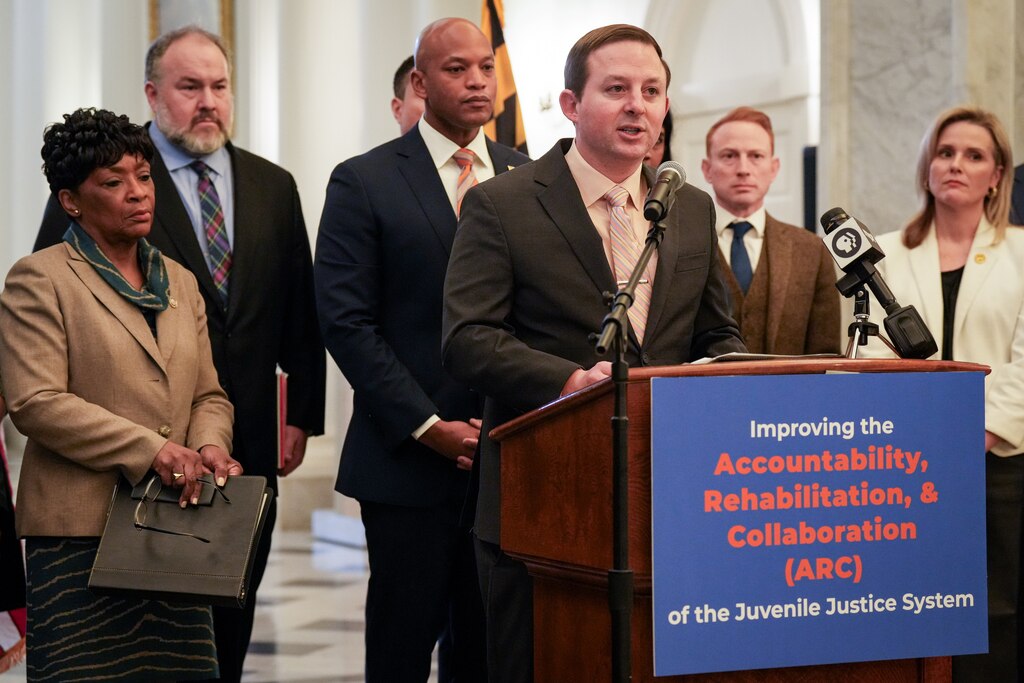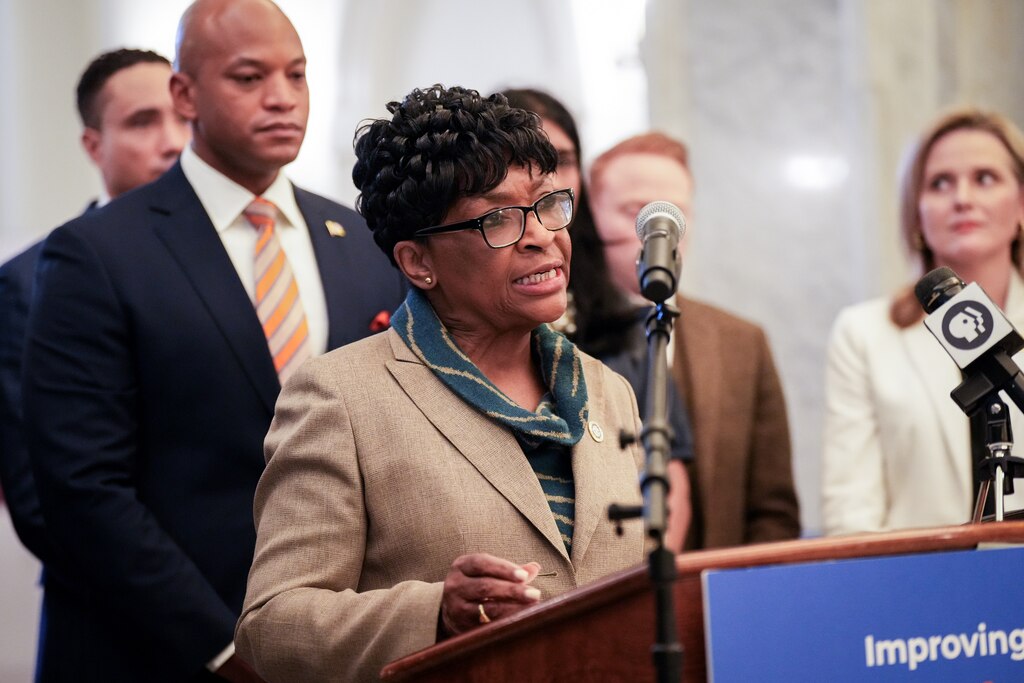Last week, lawmakers shared how they’ll rework the juvenile justice system in an attempt to curb youth crimes, such as auto thefts and handgun violations. They’ve also justified the reasoning behind those choices.
Their State House news conference, which included both chambers’ leaders and the governor, marked a reckoning for lawmakers who are paring back reforms they passed just under two years ago.
But why did they believe this was the right thing to do? And of all the measures to change, why did they choose the ones they did? And why now?
Coming into this legislative session, the leaders of Maryland’s Democratic supermajority faced public outrage over mounting auto thefts committed by children and adults and a raft of high-profile gun crimes involving teens as suspects and as victims.
The Baltimore Banner thanks its sponsors. Become one.
From the podium Wednesday, Senate President Bill Ferguson said crimes committed by teens, although less than 10% of overall crimes, contributes to a “crime perception challenge.”
Public pressure on politicians to act when children commit crimes is nothing new, Del. Luke Clippinger said, and challenges with juvenile justice have been around “since time immemorial.”
Clippinger chairs the House Judiciary Committee, which reviews the criminal system, and led hearings on juvenile justice issues at the request of Speaker Adrienne A. Jones.
When children commit crimes, “it hits people in a very emotional place,” he said, and acknowledged that the public expects lawmakers to have an “outsized response” to youth crime.
So, was the public pressure a factor in their decision making?
The Baltimore Banner thanks its sponsors. Become one.
“There is some response,” he said. “But at the same time, there’s an acknowledgement that the system has some flaws that need to be addressed.”
Why allow charging 10- to 12-year-olds?
Clippinger’s hearings at the end of 2023 revealed cracks in the system. And when the discussions ended, lawmakers had to decide what they were going to do about what they’d learned.
Part of the dilemma included how far back to push a system that the state has moved toward more rehabilitation and less incarceration. The current law is based on the recommendations made by a bipartisan council of politicians, policy experts, prosecutors and the defense bar.
The Juvenile Justice Reform Council supported setting the age of jurisdiction to 13, except in cases where younger children commit violent crimes, and shortening probation time.
But to the disappointment of youth advocates, policy experts and the Maryland public defender, the bill proposes changing measures set by the Juvenile Justice Reform Act of 2022, including new charges for kids aged 10 to 12 for nonviolent crimes, such as gun possession or auto theft.
The Baltimore Banner thanks its sponsors. Become one.
Clippinger said the legislature crafted the law in response to documented instances of elementary-school-aged children possessing guns and shooting people. Police have said young children are also stealing cars.
There are “plenty of examples,” Clippinger said, citing two from last year: A 12-year-old from Anne Arundel County who brought a gun to school and a 9-year-old who shot and killed a 15-year-old in Baltimore with his grandmother’s weapon.
Under the proposed changes, these children could have faced charges.
When events like these happen “it tends to get a lot of people’s attention,” he said.

Why extend probation?
One move legislators are using to make sure kids get rehabilitative services is to extend probation limits for misdemeanors and felonies — ratcheting them back up, but not to pre-reform levels. Services can include drug treatment, job training and mentoring.
The Baltimore Banner thanks its sponsors. Become one.
Clippinger sat on the reform council formed in 2019 that recommended reducing probation times.
“We were working from a place at that point, that you could be on juvenile probation until you were 21,” he said. “So we went in the other direction.”
But the limits set in the reform bill were too short, he said. What they found was that kids convicted for misdemeanor gun possession were on probation for six months. These children needed more time to address complex issues, such as trauma and safety, he said. The proposal extends the limit to one year from six months for misdemeanors, for two years maximum, and to two years from one for felonies, for four years maximum.
”It doesn’t mean they have to be on probation for that long,” he said. “That’s just the maximum period of time.”
He blamed a steady vacancy rate within the juvenile services agency, and staffing losses of nonprofits that provided critical rehabilitative services.
The Baltimore Banner thanks its sponsors. Become one.
“They [youths] haven’t been getting anything out of the system, really, in the recent past,” he said. “Because there hasn’t been anything for them.”
The legislation aims speed up service delivery, legislators said, but does not require the state to add funding or service providers. The bill proposes shortening the time juvenile services has to decide whether a child would benefit from services, which could, in some cases, get them to services faster.
Sen. Will Smith, who will usher the bill through his chamber, said a major frustration is the problems are “systemic, and it’s hard to kind of point to one thing.”
However, the juvenile services agency holds the biggest piece of the puzzle in getting services to kids and years of vacancies haven’t helped, the Montgomery County Democrat said.
“If you have kind of a thinning out of critical services and government services over the last eight years — this is what you get,” he said.
The Baltimore Banner thanks its sponsors. Become one.
A spokesperson for a youth advocate coalition said “kids shouldn’t pay the price for a broken system.”
“Instead of investing in programming and services that are proven to change behavior, this legislation will make us less safe by punishing children who need support and giving a pass to our state’s dysfunctional law enforcement and juvenile justice systems,” Alice Wilkerson said in a statement, speaking on behalf of the Maryland Youth Justice Coalition.
Clippinger said he does not believe children will be penalized for the state’s failings.
He said, ”I think that we have to determine what we’re going to do when kids violate the law because we are a society of laws and that’s what we have to do.”

Why more oversight?
During their monthslong probe, lawmakers said they found agencies weren’t sharing data, and weren’t collaborating in the best interests of children. So, they’ve proposed a commission to oversee all juvenile agency programs, research best practices, analyze data, review fatalities in the system and report annually to the General Assembly.
Jones, the House speaker, said kids were not being held accountable and denied services because of “an abundance of confusion.”
“Egos, political agendas and arguments over process have filled the gap,” she said. “This is unacceptable.”
These clashes between agencies, which includes state’s attorneys, played out in public forums and spurred Gov. Wes Moore to referee, telling public safety officials at all levels of government to “lead together.”
And from the State House podium, Clippinger called the lack of agency collaboration “unacceptable.”
“Everybody does just enough to check the box,” he said. “Nobody does enough to coordinate with one another to look at the kids, the kids who are in the system and to figure out how we’re going to move them forward.”





Comments
Welcome to The Banner's subscriber-only commenting community. Please review our community guidelines.